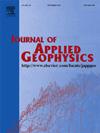用分数时间导数为粘弹性介质中的瑞利波建模,采用常数 Q 模型
IF 2.2
3区 地球科学
Q2 GEOSCIENCES, MULTIDISCIPLINARY
引用次数: 0
摘要
地震波在近地表风化层内传播时,由于其质量因子(Q)较低,往往伴随着强烈的衰减和频散现象。其中,对频散敏感的瑞利波已被证明是近地表勘探的有力工具。我们提出了一种模拟瑞利波在此类低 Q 介质中传播的新方法。我们的方法以 Kjartansson 的恒定 Q(CQ)模型为基础,使用具有记忆效应的时域分数波方程来准确描述传播过程。为了数值求解带有分数导数的波方程,我们采用了有限差分法,并结合了辅助微分方程-完全匹配层(ADE-PML)和声弹性边界法(AEA)。通过与强衰减介质中基于近常Q(NCQ)模型的传统整阶波方程进行比较,验证了该算法的高计算精度。本文的研究加深了我们对雷利波在强风化层中传播特性的理解。这一新方法有力地支持了那些依赖于地震建模的地震成像和反演方法,包括低 Q 介质内部结构的反向时间迁移和全波形反演。本文章由计算机程序翻译,如有差异,请以英文原文为准。
Modeling Rayleigh wave in viscoelastic media with constant Q model using fractional time derivatives
The propagation of seismic waves within the near-surface weathering layers, characterized by their low-quality factors (Q), is often accompanied by strong attenuation and dispersion phenomena. Among these, the Rayleigh wave, with its sensitivity to dispersion, has proven to be a powerful tool for near-surface exploration. We propose a novel approach for simulating Rayleigh wave propagation in such low-Q media. Our method uses the time-domain fractional wave equation with memory effect, based on Kjartansson's constant-Q (CQ) model, for accurate characterization of the propagation process. To solve numerically the wave equation with the fractional derivatives, we employ a finite-difference method combined with the auxiliary differential equation-perfectly matched layer (ADE-PML) and the acoustic-elastic boundary approach (AEA). The algorithm's high computational accuracy is verified through comparison with the conventional integer-order wave equation based on the nearly constant-Q (NCQ) models in strong attenuation media. The research in this paper deepens our understanding of the propagation characteristics of Rayleigh waves in strongly weathering layers. This new method strongly supports those seismic imaging and inversion methods depending on seismic modeling, including the reverse time migration and the full waveform inversion of the internal structure of low-Q media.
求助全文
通过发布文献求助,成功后即可免费获取论文全文。
去求助
来源期刊

Journal of Applied Geophysics
地学-地球科学综合
CiteScore
3.60
自引率
10.00%
发文量
274
审稿时长
4 months
期刊介绍:
The Journal of Applied Geophysics with its key objective of responding to pertinent and timely needs, places particular emphasis on methodological developments and innovative applications of geophysical techniques for addressing environmental, engineering, and hydrological problems. Related topical research in exploration geophysics and in soil and rock physics is also covered by the Journal of Applied Geophysics.
 求助内容:
求助内容: 应助结果提醒方式:
应助结果提醒方式:


